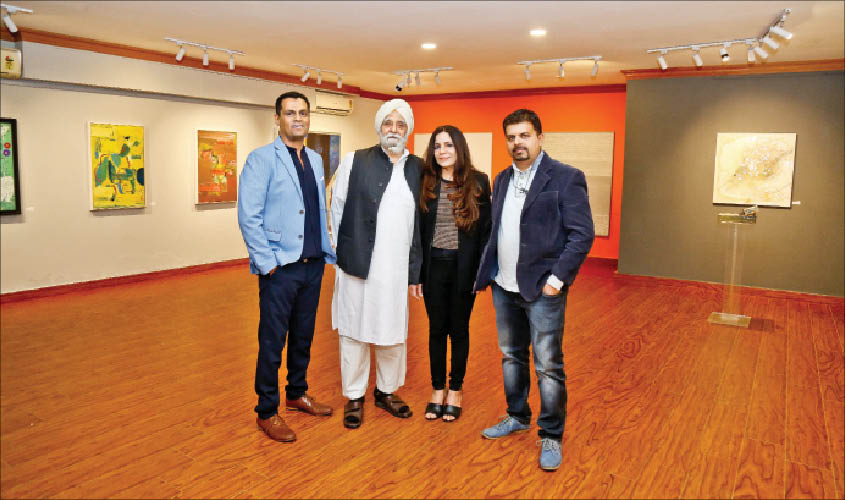First set up in 1964, Delhi’s Gita Art Gallery was re-launched earlier this month in a new avatar. It is now called GAG Moderne and is run by two young artists who have big plans for the gallery’s future. Bhumika Popli writes about GAG’s second innings.
One of Delhi’s oldest art establishments, the Gita Art Gallery had all but disappeared from the city’s cultural map. There were only a handful of shows hosted there for around two decades, and it seemed like a place going to seed. Until a few weeks ago, when the gallery was re-launched under the name of GAG Moderne.
It was first set up at the The Oberoi hotel here, by Kuljeet Singh Butalia, in 1964. Then, in the year 2000, the gallery was relocated to Sadhna Enclave, where it still stands, now called the GAG Moderne.
Butalia, now 93, has now passed the baton to Neha Talwar and Anirudh Tripathi, who are artists themselves, and are overseeing operations at the revamped gallery. Back in the day, the Gita Art Gallery hosted few shows on its premises, focusing mostly on the sale and purchase of artworks. But now, the new directors aim to use the GAG Moderne to identify and promote emerging talent.
The new gallery has two spacious halls and a terrace. There’s an office here as well, which displays a couple of paintings by M.F. Husain. Sitting here, Butalia spoke to Guardian 20 about his career as a gallery owner and promoter of Indian modernists.
Between 1964-74, he maintained an impressive roster of Indian as well as international clients, one of whom was the famous American carpet dealer Harry Flitterman. “He [Flitterman] took a fascination to Husain’s work and ended up buying six from me instead of the one he had earlier thought of,” says Butalia.

The gallerist himself was close to Husain. “We used to hang out together, having coffee and visiting art shows. I remember on the occasion of Guru Nanak’s birthday, I went to a gurudwara and Husain asked me, ‘Why are you feeling so religious today?’ I told him about the relevance of the occasion. On the same day, by the time I finished my lunch, he made a portrait of Guru Nanak Dev for me, which still hangs in my drawing room. I supported the stellar artist in whichever way possible and I believe the new directors would do the same for contemporary artists,” says Butalia.
The new directors were chosen after a rigorous selection process. Neha Talwar was trained to be an artist under Rameshwar Broota, and Anirudh Tripathi is a self-taught multimedia artist. Both also run a studio together, called NeAnGo, with another artist, Gopal Mehan.
The GAG Moderne directors would be taking up many initiatives in the coming months, but their primary objective would be to promote artists who have devised new ways of creating art.
The gallery’s first show, entitled Paradox of Silence, which opened with the re-launch of the gallery space earlier this month and concludes on 31 March, is designed to serve the same purpose, of putting the spotlight on new artists.
“In this group show, we have featured works by many artists who are challenging themselves by offering novel artworks. Shobha Broota’s work is a great example of moving from traditional paintings techniques, like oil-on-canvas, to working with wool threads on canvas. Same goes for Mona Rai, who is working with found materials and embroidery,” says Talwar.
Tripathi shares his vision of showcasing new talent through this gallery. He says, “May 2019 onwards, we will be going to many artists to understand their creative ideas. The aim is to find those artists who are quite serious in their creative practice. We also want to look at those artists who are doing multidimensional works. There are many artists who are working with newer materials and techniques but sadly they never come to the forefront. The plan is to go all over India with senior artists for a sort of talent search for young artists.”

An artist-led gallery sounds like an exciting prospect. Especially in a city like Delhi, where artists’ interests take a backseat and galleries are run on the profit principle. But with their energies directed to this ambitious project, would the two directors still have time for their own art practices?
“We feel more energetic every day. Our schedule is packed, and we feel that now we are spending our day more productively than before,” says Tripathi.
The duo aims to take Indian art to international galleries as well, and have already started the process of reaching out. “It was a surprise to know that many international galleries don’t have a single piece of work from an Indian artist,” adds Tripathi.
In its new avatar, the gallery will also serve as a forum for exchanging ideas. “On 30 March, we have planned an art talk with poet-critic Ashok Vajpeyi and artist Manish Pushkale. After that, there is a plan to devise a series on art therapies among other such events. The halls won’t just feature paintings but installations, photography, sculptures, video art and other new forms as well. We want to give a wholesome experience to viewers,” says Talwar.
The directors have a long-term plan for the gallery—to make it a launching pad for new artists and a way station between the Indian art scene and the international gallery circuit. “The aim is to promote the best of artworks in such a way that 20 years from now India, too, gets a considerable recognition the world over,” says Talwar.

